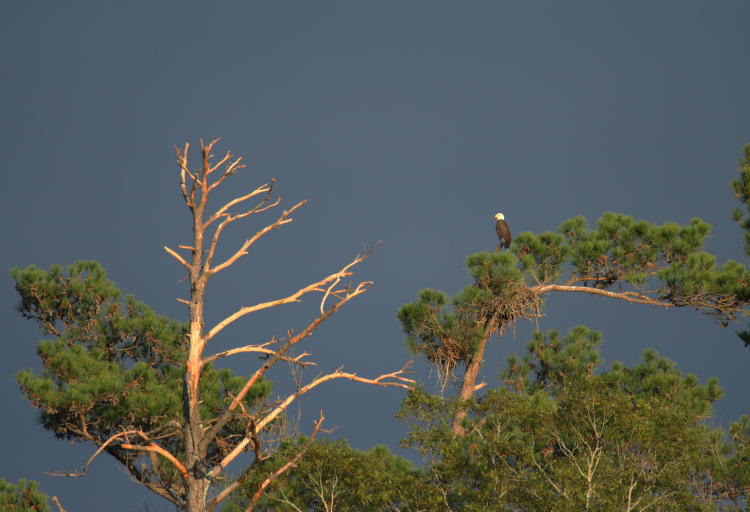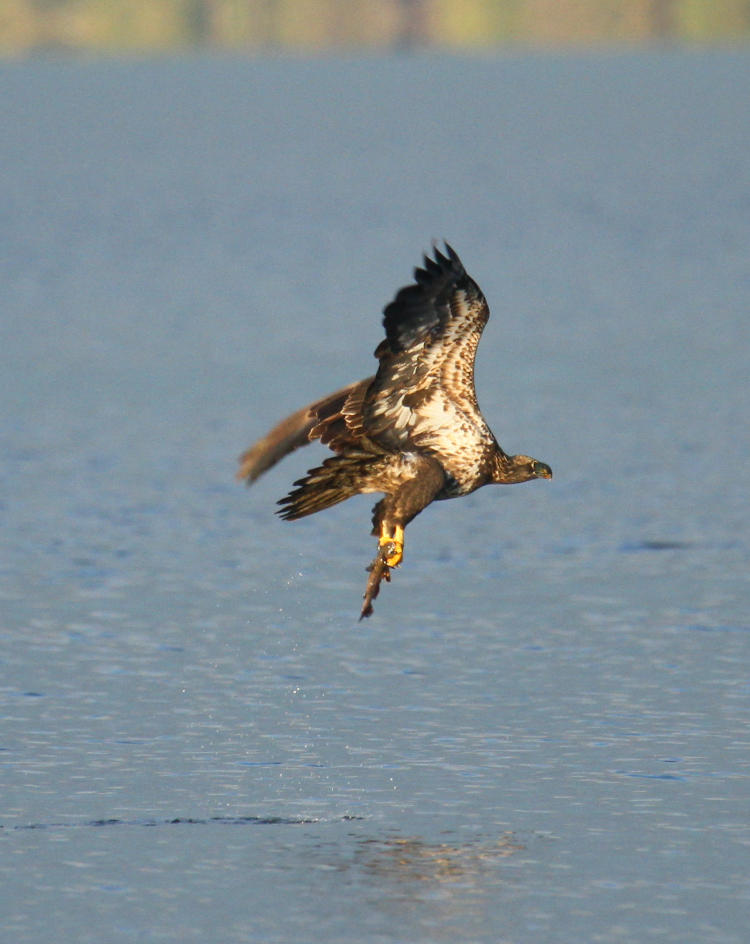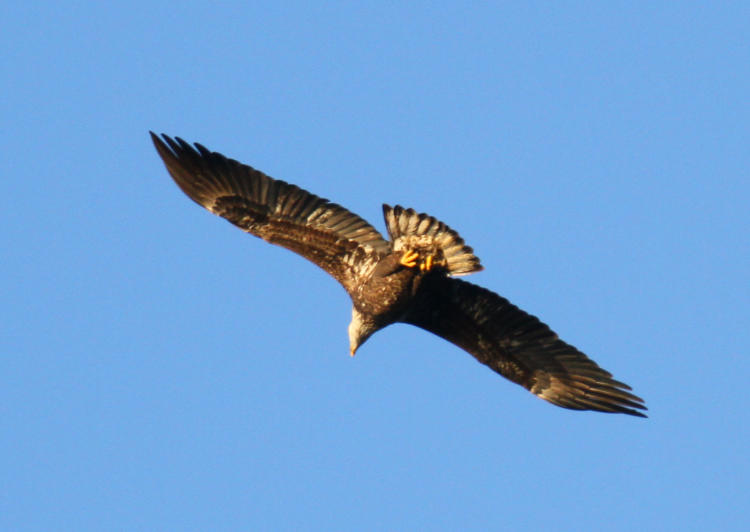It’s easy to get into a rut – or at least, it is for me. Depending on conditions and location, I realize that I’m finding mostly the same subjects, and I try tempering what I post because it’s a lot of photos of the same damn thing. And then, like earlier in the year, things change and suddenly I’m in a different rut, too many of another subject. Right now, it’s like driving a crappy country road where you have no choice but to jump back and forth between ruts, but I’m taking slight advantage of this one because I have more frog and lizard photos waiting in the blog folder.
So, a ‘sunset’ outing to Jordan Lake yesterday at least provided some new/old subject matter. The lake is not a good place to find green treefrogs or Carolina anoles, but it is a good place for other things. At times, anyway.

The initial conditions, for better than half of the outing in fact, were overcast, and there was little activity to be seen. A perched great blue heron (Ardea herodias) lay ahead of us along our path and we knew it would get spooked off eventually, so I took advantage of a gap in the trees for a closer portrait before we got too far. Within another minute it decided to vacate to quieter portions of the lakeside.
Ospreys and bald eagles made appearances, but little more than that, and they were framed against grey clouds in lower light, so most of the efforts produced nothing worthwhile. On the horizon, a break in the overcast slowly marched eastward, producing a small patch of blue sky, but too few of the birds chose to pose against it, demonstrating that, at least around Jordan Lake, the raptors have no fashion sense.
Eventually we switched to a different location, really only a couple of kilometers away but facing in the opposite direction, and the bare patch advanced resolutely. Since it was late in the afternoon, this soon produced bright sunlight peeking through at a low angle, which allowed some nice lighting, like for this very distant bald eagle (Haliaeetus leucocephalus.)

This is at 600mm and cropped a little at that, so you know the eagle was quite far off – easily over a kilometer – and showing no inclination to go for some exercise, but the light conditions were pretty cool.
A few great egrets (Ardea alba) were nearby – closer at least than the eagle – but not providing much in the way of poses or settings, and still too low to catch that sunlight, but eventually a pair of them launched themselves from the shore and cut out across the water, getting into better light as they did so.

Yes, that’s a tiny little fish in its beak, barely enough for a snack, and why the egret didn’t scarf it down before taking flight I cannot say; there were no apparent threats and we were still a long ways off ourselves, but maybe it was trying to protect its capture (a grandiose term for something too small to make good bait) from its companion, who followed close behind.
A very large number of black vultures passed overhead over a period of a few minutes, all heading in the same direction, so I’m assuming they were returning to their evening roosts, since the sun was less than an hour from setting at this point. Much better, however, were the pair of juvenile eagles that started playing tag right over our position.

For a few moments, they were close enough to get in the same frame, they just didn’t do it when they were facing the right way or banked to catch the light – again, oblivious models, but what can you do? One did get a lot more cooperative as it split off from the other and stated hunting.

Normally the feet are tucked well back, so when they drop like this, it’s usually an indication that the eagle (or osprey) is about to descend for a fish, called a stoop (I say this to other people at times, and they usually think I’m being derogatory of the birds.) There were a couple of hesitations, but sure enough, the eagle dropped down towards the water purposefully.

The sky wasn’t completely clear, plus there were some taller trees on the lakeshore in that direction, so the eagle passed out of better lighting momentarily. That uniformly dark head but paler breast marks this as likely second-year, having hatched in spring of 2020. I point this out because we’ll come back to it.

For once, autofocus behaved as the view crossed the horizon, and I was able to get the moment of capture as the eagle skimmed low over the water at a reasonable clip. Unlike the osprey, all of the eagles that I’ve observed don’t dive into the water, but snag their captures from just beneath the surface as they cruise overhead. There are a couple of reasons for this, all speculative right now: the bird wants to avoid getting waterlogged and having to expend the energy lifting itself from the water afterward, which is significant for something this heavy; or the eagle’s profile is noticeable enough that it approaches quickly and obliquely because it’s less likely to scare the fish off this way. I want to point out that the initial spotting of the fish usually takes place over a hundred meters off, and the eagles stay on target throughout a twisting dive and while crossing several different reflecting and refracting conditions from the water, since a lower angle will drastically change how the surface appears. It’s possible that eagle eyes are naturally polarized, greatly reducing reflections from the water – I should look this up.

But yeah, this time the light angle was excellent, and the successful capture could clearly be seen. Knowing the size of eagles, the fish is likely just a little less than the length of your hand. Obviously not a huge meal for the bird, but likely the last for the day.
Now it gets a little interesting. There were faint signs of an altercation between the two eagles as they passed out of sight behind some trees, but nothing too serious. And then the other eagle appeared holding a fish.

As you can tell from the plumage, this is clearly not the same one we just saw, and clearly in possession of a meal. They’d been wheeling overhead for a couple of minutes at this point and had performed no fishing actions, except that pictured above, while in sight. I’m used to seeing eagles catch something and then find a perch, usually some distance away, to eat it, so this was different, and I wasn’t sure that this one hadn’t stolen the fish. We’ll take a moment here to point out the age of the eagle, since they have specific coloration for the first four years of their lives, before they have the classic adult plumage that we all know. The head is clearly going white here, but the tail is not, and the underwings still sport the mottled markings of the juvenile, so I’m placing this as right at the fourth year. Feathers don’t change color of course, so they have to be molted out for new, differently colored ones to take their place, and this happens a few at a time, usually in matching pairs so the bird does not have uneven aerodynamics.

Another look at that same one – not the best, but with the low light angle, only at times would the eagle show its colors clearly; at others, it would be more backlit and not showing much more than a silhouette like above. But the underwing markings and the not-white tail show clearly here – and one other thing. These are only seconds apart and the eagle clearly did not drop (or gobble) the fish, but it’s no longer visible here, tucked well up against the tail.

And we return to the first, once again showing possession of the fish – I spent a bit of time going back and forth between the frames to ensure myself of the timing of these appearances. So we have two things of note: the first is, they were both wheeling around while clutching meals, not inclined to actually eat them too quickly, which has me curious. The second is, they were clearly not siblings, being a couple of years apart in age, yet hanging out together with only the faintest hint of antagonism, and that took place mostly behind trees so I’m not even sure about that. Right now, just adding it all to my internal catalog of behaviors that I wouldn’t have expected.
Also note the uneven appearance of the back of the wings, the trailing edges. This one is molting, slowly losing feathers as they push outwards, soon to be replaced by new ones, but in the interim there will be a gap in the uniform appearance. Go on back up, if you’re inclined, to compare the wings of the two.
The best shot of the evening actually came earlier – I know, I’m placing buildup over chronology; what kind of a nature photographer am I? Nobody cares, including me, so let’s plow on. Not long after arriving at the new location, we spooked a great blue heron from a perch within the trees overhead, and it flew out over the water (again, into excellent light,) croaking as it did so. But then it turned back, wheeling around and coming almost directly towards us, which I found extremely curious because there as no doubt in my mind that we were the ones that caused it to take flight. Examining the frames afterward gave a hint of the reasoning, however.

I have several frames with the head and eyes in largely the same position, so it’s clear that the heron spotted something promising in the water as it took flight and came back around to examine it, us be damned. After a few seconds, it determined that these fish (or perhaps a Soviet-era sub – ya never know) didn’t merit further study and turned away again, providing a perfect light angle as it did so.

This isn’t quite full frame, being cropped a little just to fit with blog usage better – just add more of the same around the outer edges if it bothers you. But this shows the framing and position well enough (plus the last vestiges of the clouds,) while we now go in closer for the detail.

When you can actually convince the birds to play nice at those times (which is a big ‘when,’) late afternoon or early morning, when the sun is low and golden or orange or even pink, is a great time to catch birds in flight. But of course they have to bank at the right angle, and you have to be in position yourself to take advantage of this. The shadows give a lot of definition to the individual wing feathers while the light shows off all the different colors of the bird, and of course now it’s looking directly at us. While this could be debated, given that the eyes face out from both side of the head, it was also pretty close to us and, again, we were the ones that made it take flight, so I stand by my statement.
Having started the outing in full overcast, the sky transitioned to almost completely clear, with just a hint of the cloud cover low to the east, and actually made for a clear and boring sunset, not even any decent colors from the sky. I’ve found this to happen more often than not in North Carolina, which is why I don’t chase sunset here too often – I definitely have more consistent luck in other locations. So it goes.



















































